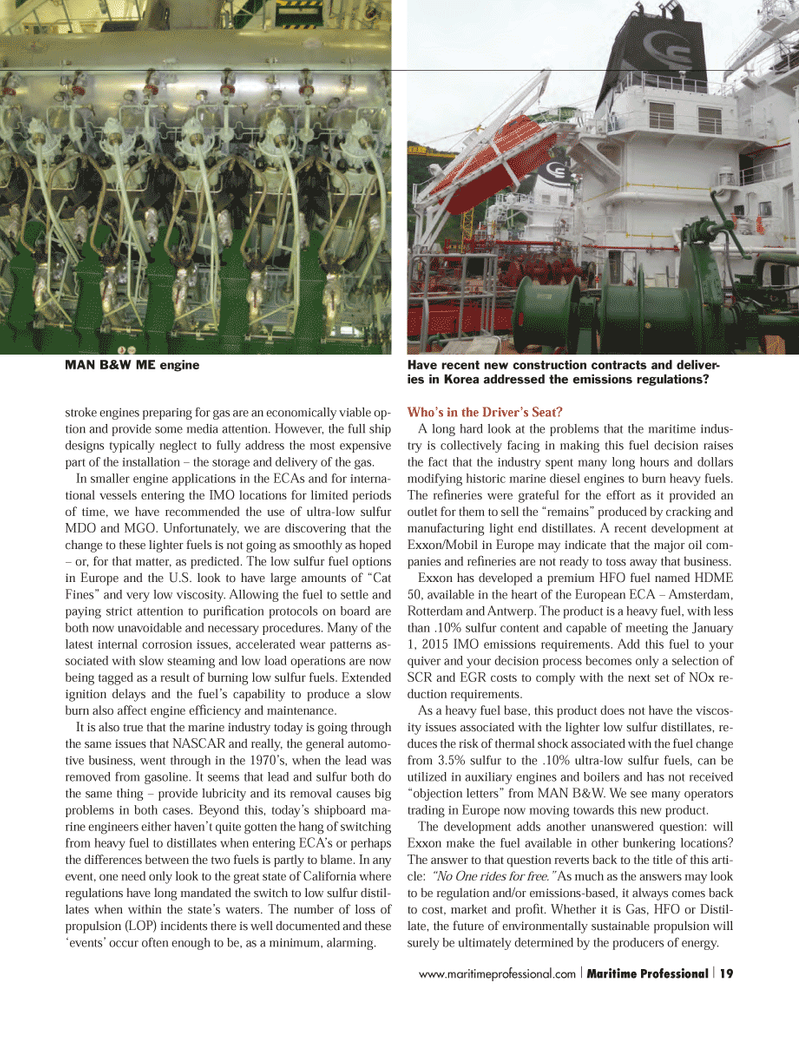
Page 19: of Maritime Logistics Professional Magazine (Q3 2014)
Power & Fuel Management
Read this page in Pdf, Flash or Html5 edition of Q3 2014 Maritime Logistics Professional Magazine
stroke engines preparing for gas are an economically viable op- tion and provide some media attention. However, the full ship designs typically neglect to fully address the most expensive part of the installation ? the storage and delivery of the gas. In smaller engine applications in the ECAs and for interna-tional vessels entering the IMO locations for limited periods of time, we have recommended the use of ultra-low sulfur MDO and MGO. Unfortunately, we are discovering that the change to these lighter fuels is not going as smoothly as hoped ? or, for that matter, as predicted. The low sulfur fuel options in Europe and the U.S. look to have large amounts of ?Cat Fines? and very low viscosity. Allowing the fuel to settle and paying strict attention to puri cation protocols on board are both now unavoidable and necessary procedures. Many of the latest internal corrosion issues, accelerated wear patterns as-sociated with slow steaming and low load operations are now being tagged as a result of burning low sulfur fuels. Extended ignition delays and the fuel?s capability to produce a slow burn also affect engine ef ciency and maintenance. It is also true that the marine industry today is going through the same issues that NASCAR and really, the general automo- tive business, went through in the 1970?s, when the lead was removed from gasoline. It seems that lead and sulfur both do the same thing ? provide lubricity and its removal causes big problems in both cases. Beyond this, today?s shipboard ma- rine engineers either haven?t quite gotten the hang of switching from heavy fuel to distillates when entering ECA?s or perhaps the differences between the two fuels is partly to blame. In any event, one need only look to the great state of California where regulations have long mandated the switch to low sulfur distil- lates when within the state?s waters. The number of loss of propulsion (LOP) incidents there is well documented and these ?events? occur often enough to be, as a minimum, alarming. Who?s in the Driver?s Seat? A long hard look at the problems that the maritime indus-try is collectively facing in making this fuel decision raises the fact that the industry spent many long hours and dollars modifying historic marine diesel engines to burn heavy fuels. The re neries were grateful for the effort as it provided an outlet for them to sell the ?remains? produced by cracking and manufacturing light end distillates. A recent development at Exxon/Mobil in Europe may indicate that the major oil com-panies and re neries are not ready to toss away that business. Exxon has developed a premium HFO fuel named HDME 50, available in the heart of the European ECA ? Amsterdam, Rotterdam and Antwerp. The product is a heavy fuel, with less than .10% sulfur content and capable of meeting the January 1, 2015 IMO emissions requirements. Add this fuel to your quiver and your decision process becomes only a selection of SCR and EGR costs to comply with the next set of NOx re- duction requirements.As a heavy fuel base, this product does not have the viscos- ity issues associated with the lighter low sulfur distillates, re- duces the risk of thermal shock associated with the fuel change from 3.5% sulfur to the .10% ultra-low sulfur fuels, can be utilized in auxiliary engines and boilers and has not received ?objection letters? from MAN B&W. We see many operators trading in Europe now moving towards this new product. The development adds another unanswered question: will Exxon make the fuel available in other bunkering locations? The answer to that question reverts back to the title of this arti- cle: ?No One rides for free.? As much as the answers may look to be regulation and/or emissions-based, it always comes back to cost, market and pro t. Whether it is Gas, HFO or Distil- late, the future of environmentally sustainable propulsion will surely be ultimately determined by the producers of energy. MAN B&W ME engineHave recent new construction contracts and deliver- ies in Korea addressed the emissions regulations? www.maritimeprofessional.com | Maritime Professional | 1918-33 Q3 MP2014.indd 1918-33 Q3 MP2014.indd 198/13/2014 3:32:39 PM8/13/2014 3:32:39 PM

 18
18

 20
20
